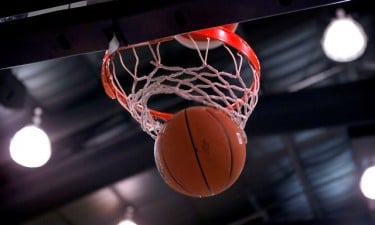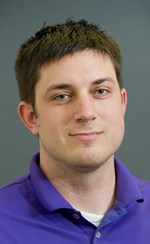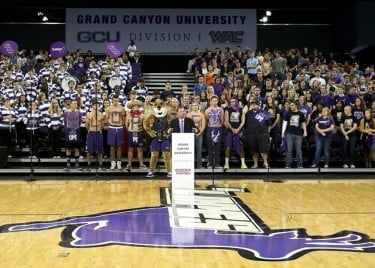Last of a five-part series
Story by Rick Vacek
Photos by Darryl Webb
GCU News Bureau
Of all the lessons learned in the transition from NCAA Division II to D-I, one stands out in the minds of administrators and coaches interviewed.
This will be a moving target. A plan is only a plan. Flexibility is everything.
“Everyone told me, ‘You can’t understand the needs until you’re in it,’” said Dana Skinner, director of athletics at the University of Massachusetts Lowell, “and that certainly has been the case.”
Abilene Christian University's director of athletics, Jared Mosley, said: “You try to research everything on the front end, but you always know there will be things on the back end you didn’t anticipate. You have to remind yourself it’s a process.”
Everyone from directors of athletics to compliance officers to media relations personnel have felt the knot in their stomach that comes with the uncertainty of their new challenge.
“You’re excited but you’re wondering, ‘How is this going to work?’ A lot of education is involved,” said Shane Meling, assistant athletic director of sports information at University of the Incarnate Word. “You kind of feel like you’re out there in no man’s land and you’re not sure if you’re doing the right thing or not.”
In looking at what’s ahead for Grand Canyon University and the other five transitioning institutions in the 2014-15 school year, it’s important to understand where they’ve been and what has worked. This is not a one-size-fits-all situation. For example, the Western Athletic Conference does not have wrestling, so GCU’s team was left to fend for itself in scheduling. Other universities faced similar challenges; it’s like trying to buy shoes when one of your feet is size 9 and the other is size 12EEE.
A key part of the education of administrators has been to compare notes with their peers. When Grand Canyon took the D-I plunge, its director of athletics, Keith Baker, reached out to officials at the University of Nebraska Omaha, which went D-I in 2011, and Northern Kentucky University, which is one year ahead of GCU in the four-year transition requirement. Relationships blossomed.
“I think that’s the good part – there’s a little bit of camaraderie among the schools going through this,” Baker said.
For example, when Josh Meyer, GCU’s assistant athletic director of student services, has a question, one of his go-to guys is Josh White, associate athletic director at Nebraska Omaha. Transition Six officials have had meetings among themselves, including one recently, to compare notes.
Indicative of that togetherness is that they play one another a lot in competition. It’s not always easy for D-I newcomers to get games, but a call to a fellow Transition Six member usually will get a green light on a game in just about any sport. For example, in the 2014-15 school year GCU is scheduled to compete against transitioning universities in men’s and women’s basketball, men’s soccer, women’s volleyball, and swimming and diving.
Their talks among themselves are about academics and compliance far more than athletics, and with good reason. “If it doesn’t work in the classroom, the transition to D-I just doesn’t work,” Trev Alberts, director of athletics at Nebraska Omaha, told GCU Today last year.
Jeff Fore, director of student-athlete academic support, said the overall grade-point average for the 450 athletes at GCU in the 2013-14 school year was 3.33 on a four-point scale, well above the campus average, and 247 met the minimum requirement for being named all-academic in the WAC. Eight teams had cumulative GPAs of 3.5 or better, and 77 percent of all athletes were at 3.0 or better.
"Academically, we had tremendous results across the board," said Brian Mueller, GCU's president and CEO. "It shows that you can be successful academically and also athletically and don't have to sacrifice one for the other."
Fore, who came to GCU two weeks before the start of the 2013-14 school year and was charged with forming the academic-support wing of athletics, is focused on more than just grades. His team is a one-stop shop for everything the athlete needs in academics and beyond, including character development, leadership training and preparation for getting a job after graduation. “Kind of like backpack to briefcase,” he said.
Trent May, GCU's women’s basketball coach, credited Fore for making sure May's players got things worked out with their professors when they were away from campus for the entire week of finals in December. Fore went on the trip with the team and administered more than 40 final exams. “It worked out amazingly well,” May said.
Fore and his staff do learning-style analyses when athletes first arrive on campus to find out what kind of learners they are (visual, auditory, etc.) and then act quickly if they get word that an athlete is having academic difficulties.
“They’ll say things like, ‘Things are fine.’ Very competitive athletes hate to ask for help,” Fore said. “You’ve got to get them to trust you. If they flunked a test, you need to figure out why.”
On compliance issues, Meyer is in touch with coaches regularly to make sure the staff understands what’s in the NCAA Division I Manual, which looks like a college textbook and is 290 pages of complex legal jargon that has to be deciphered before it can be digested.
To help it go down easier, every two weeks Meyer sends an email, patterned after the GCU Today Digest sent to employees, containing useful tidbits and teaching points for coaches and athletics staff. He also does a monthly newsletter. He has created 40 new documents in the last year to track compliance issues, and now he’s in the process of trying to refine them.
“There is no room for error,” he said. “We can’t screw up. We get phone calls all the time from people at other schools asking, ‘How are you so competitive?’”
GCU’s success, following up on its history of winning in D-II, was not unanticipated. Baker said one of the first messages that Mueller delivered to coaches and athletics staff when the D-I move was announced was this: “Do it the right way because people will be looking at us.”
Meyer was stunned by the way GCU officials were peppered with questions at the recent Transition Six gathering. Clearly, Grand Canyon’s success has been a trend-setter, and Mueller said his goal is that "people will start to view us as an academic institution that has academics and athletics in the proper perspective. Our teams compete well – there's a lot of winning. But all that is done in the context of strong academics."
GCU could get noticed even more, especially if its teams continue to win, in Year 2 of the D-I move for a simple reason: This is where most transitioners struggle the most.
The other administrators generally agreed that, in the four-year transition period, the first year might be the easiest one except for getting accustomed to all the new rules.
The reason is simple. In the first year, everyone’s excited. The athletes and coaches want to show what they can do. Momentum takes over.
“You can feel it in Year 1,” Skinner said. “There’s so much energy. This has been such a rallying opportunity.”
But the subsequent years, especially Years 2 and 3, can be tougher for several reasons:
- Baker pointed out that even if a team had veteran players for Year 1 and did fairly well, they’re going to graduate and the newcomers are going to have to jump into D-I, ready or not, in Year 2 or 3.
- Recruiting can be challenging. Some athletes have a hard time accepting the idea of not being able to go to the NCAAs until late in their careers and would rather go elsewhere. Transitioners cannot go to the NCAAs and in team sports aren’t even eligible for the conference tournament. However, Mueller said the reports he's getting are that GCU's recruiting "is going very well in all sports" and that the D-I transition limitations are having little to no effect on "the kind of athletes we're able to recruit."
- The surprise factor is gone. For example, the GCU softball team isn’t going to be able to sneak up on anyone in the WAC after winning the conference in its first try.
- Athletes are human. It’s tough to play game after game on the road against good opponents. Any team would struggle with that.
Of course, coaches don’t want to hear excuses. And they certainly don’t want to get ahead of themselves.
“For us, every year is a sense of excitement,” said May, who next season will have 11 players who will be putting on a GCU uniform for the first time. “We have so much to be concerned with in Year 2 (that) Year 3 seems far away.”
Year 2 at GCU will start with the reopening of newly expanded GCU Arena. The University is scheduled to get a temporary certificate of occupancy on Aug. 22, and the first scheduled event is the Chapel service on Sept. 8. The Arena will seat about 7,000, up from 4,238.
You can be sure that GCU will do everything in its power to ensure that people in Phoenix hear about it. Baker said of Mueller: "He just has a great marketing mind. He's always looking for ways to hook up with other entities in town."
On the compliance side, NCAA officials will visit campus sometime in early 2015 to get a firsthand opinion of how GCU looks and feels in the transition process. And there’s no telling what will happen with the NCAA's structure in the next year and beyond, considering all the talk of the five wealthiest football conferences breaking away and making their own rules.
But, assuming GCU still has three years of transitioning left, there should be some challenges along the way. Consider the fact that Northern Kentucky University, which just completed Year 2, had a combined record of 46-116 in men’s and women’s basketball, baseball and softball (although its 5-45 record in softball had much to do with that). Only the women’s basketball team won more than it lost, and only one other team sport, men’s soccer, had a winning record.
“I think the second year can often be the toughest year,” said Ken Bothof, who became NKU’s director of athletics nine months ago. “I’ve heard this from other people, too.”
Having just gone through the experience of Year 2, what would be his advice for GCU?
“I would tell people to just be patient,” he said.
Remember, it’s a virtue.
ALSO IN GCU TODAY: Geography, an arena and planning have aided the transition at Northern Kentucky University.
ABOUT THIS SERIES:
Part 1: GCU came up a winner in Year 1 of D-I. Sidebar: Nebraska Omaha.
Part 2: How three veteran coaches approached and managed the first year. Sidebar: University of the Incarnate Word.
Part 3: Antelope athletes talk about what it took to move up to D-I from D-II. Sidebar: Abilene Christian University.
Part 4: GCU isn't the only university trying to establish itself in a competitive sports market. Sidebar: University of Massachusetts Lowell.
Part 5: Changes and challenges often mark the second year of the D-I transition. Sidebar: Northern Kentucky University.
Contact Rick Vacek at 602.639.8203 or [email protected].



















